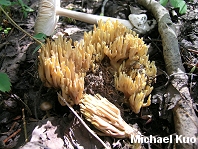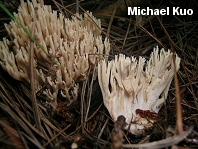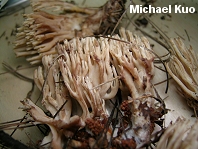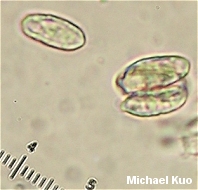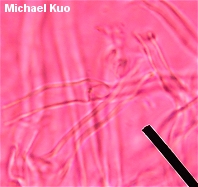| Major Groups > Clubs & Corals > Ramaria stricta |

|
Ramaria stricta [ Basidiomycetes > Phallales > Ramariaceae > Ramaria . . . ] by Michael Kuo Ramaria stricta grows from wood--though the wood is often buried. It features branches that are usually "strictly" oriented, so that they are mostly straight and ascending. When fresh, its branch tips are yellow and its branches are dull yellowish buff, but its surfaces bruise and discolor purplish brown. Under the microscope it features roughened spores, clamp connections, and thick-walled hyphae. Several very similar species have been separated by mycologists (see below), and the name Ramaria stricta should probably represent a group of potential species awaiting contemporary study. Ramaria concolor is slightly darker but virtually identical, featuring branch tips that are not yellowish to yellow and are, instead, colored like the branches; Ramaria apiculata features branch tips that are often greenish, and differs in the microscopic structure of its rhizomorphs. Several varieties of these species have been described (see Petersen, 1975). Description: Ecology: Uncertain; while most ramarias are thought to be mycorrhizal, the wood-inhabiting species could be mycorrhizal or saprobic; growing from the dead (but sometimes buried) wood of conifers (and sometimes hardwoods); appearing alone, scattered, or gregariously; early summer through fall; apparently widely distributed in North America, but more common from the Rocky Mountains westward. Fruiting Body: 4-14 cm high; 4-10 cm wide; base well developed or nearly absent; branching repeatedly. Branches: Vertically oriented and elongated; often flattened; smooth; yellowish buff, becoming orangish buff as the spores mature; bruising and discoloring purplish brown; tips yellow when fresh and young. Base: Nearly absent, or fairly well developed; to 2 cm wide; white below; colored like the branches above; attached to numerous white rhizomorphs. Flesh: Whitish; fairly tough. Odor and Taste: Odor not distinctive, or sweet and fragrant; taste bitter. Spore Print: Rusty yellowish. Chemical Reactions: Iron salts green on branches; KOH orangish to brownish on branches. Microscopic Features: Spores 7.5-10.5 x 3.5-5 µ; stretched-elliptical; roughened. Clamp connections present. Thick-walled hyphae present. REFERENCES: (Persoon, 1797) Quélet, 1888. (Fries, 1821; Saccardo, 1888; Coker, 1923; Corner, 1950; Petersen, 1975; Smith, Smith & Weber, 1981; Weber & Smith, 1985; Arora, 1986; Phillips, 1991/2005; Lincoff, 1992; Metzler & Metzler, 1992; Barron, 1999; Roody, 2003; McNeil, 2006; Miller & Miller, 2006.) Herb. Kuo 08160711, 07290801. This site contains no information about the edibility or toxicity of mushrooms. |
© MushroomExpert.Com |
|
Cite this page as: Kuo, M. (2009, May). Ramaria stricta. Retrieved from the MushroomExpert.Com Web site: http://www.mushroomexpert.com/ramaria_stricta.html |
